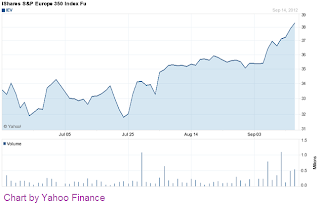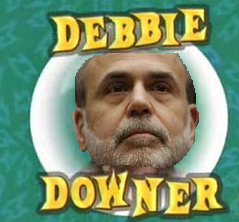Consumer Confidence is Hopeful at Best
Our founder earned clients a 23% average annual return over five years as a stock analyst on Wall Street. "The Greek" has written for institutional newsletters, Businessweek, Real Money, Seeking Alpha and others, while also appearing across TV and radio. While writing for Wall Street Greek, Mr. Kaminis presciently warned of the financial crisis.
Consumer Confidence
Because the cutoff date for the survey was September 13, it only benefited ever so slightly from the Federal Open Market Committee (FOMC) monetary policy announcement and quantitative easing declaration. Still, it obviously benefited from the buildup of expectations for it through the month. Along with stocks, I believe it also has Mario Draghi and his creative and aggressive action, which I believe has effectively mitigated the European debt crisis (note, the economic crisis goes on), to thank. Of course, the mood of consumers is going to be less closely tied to the direct actions of the ECB at close proximity to those actions, and more responsive to the effects of those actions. It will more immediately be driven by the gains of capital markets and stocks, given the widespread ownership of them through retirement savings accounts.“The whim of hope is represented here without a trace of tangible prosperity to anchor to.”
However, the consumer confidence gain, while hinged on the rise of forward looking equities and not on the employment situation or the pace of GDP, is superficial. The same superficiality applies for stock valuations in my opinion. You can see the consumer superficiality in the details of the report itself and in anecdotal data about the economy and corporate outlook. The Expectations Index, a measure of forward looking feelings for consumers, gained by 12.6 points on its way to a mark of 83.7. The whim of hope is represented here without a trace of tangible prosperity to anchor to.
The Present Situation Index, which better reflects how things really are today among Americans, also gained, but by only 3.7 points to a still unimpressive level of 50.2. And when you look more deeply into where specific surveyed issues ranked and what little the “improvement” actually means, you understand how hopeful this index really is today.
Surveyed Issue
|
Level
|
Change
|
Business
Good
|
15.5%
|
+0.2%
|
Business
Bad
|
33.3%
|
-1.0%
|
Jobs
Plentiful
|
8.3%
|
+1.1%
|
Jobs
Hard to Get
|
39.9%
|
-0.7%
|
Business
to Improve
|
18.2%
|
+1.5%
|
Business
to Worsen
|
13.8%
|
-3.8%
|
Expect
More Jobs
|
18.5%
|
+2.7%
|
Expect
Less Jobs
|
18.5%
|
-5.2%
|
In my view, consumers are less relevant respondents with regard to forward looking information. I think this is evident in the relatively lower overall response rate to the last four rows of the survey topics depicted above here. Also, they are nearly evenly divided on forward looking issues, and certainly less opinionated with regard to the outlook, which may simply reflect uncertainty. Uncertainty, in and of itself, is bad for equities, and probably to some lesser degree, also bad for consumer spending. Looking at the jobs and business questions for the present time, sentiment improved, but remains at absolutely poor levels.
Another report also issued today showed real consumer spending softening. The weekly chain store sales data reported by the International Council of Shopping Centers (ICSC) showed a week-to-week sales gain of just 0.6% in the period ending September 22nd, and that followed the prior week decline of 2.5%. Now these data may be holiday impacted, but the year-to-year change was also relatively unimpressive at +2.9% (last week it was +2.1%). The rate of growth barely edges inflation, with the latest Consumer Price Index showing price rise of 1.9% year-to-year in August, excluding food and energy price change. Redbook reported year-to-year chain store sales today up just 2.0%.
Anecdotal evidence among a significant number of companies shows a tighter competitive environment, as consumers selectively choose within perhaps saturated retail capacity. In tight economic conditions, if shopping activity loses robustness, then there will be less pie to share among competitors. For this reason, companies like J.C. Penney (NYSE: JCP) and Sears (Nasdaq: SHLD) are finding difficult times and resolving to profound change in operating strategy. For this reason, shoppers are gravitating towards lower cost value store options, driving market share gains for the likes of Wal-Mart (NYSE: WMT), eBay (Nasdaq: EBAY), Amazon.com (Nasdaq: AMZN) and Dollar Tree (Nasdaq: DLTR).
So, despite this latest consumer confidence swing, I suggest investors look toward more tangible evidence of consumer spending, like that seen in the chain store sales data. This Friday, an even better measure of the consumer mood will be reported. Look toward the Personal Income & Outlays data, and what it says about real consumer spending, excluding the impact of price change, for a better guide into the state of mind of American consumers.
Please see our disclosures at the Wall Street Greek website and author bio pages found there. This article and website in no way offers or represents financial or investment advice. Information is provided for entertainment purposes only.
Labels: consumers, Consumers-2012-Q3, Economic-Reports, Economic-Reports-2012-Q3, Economy, Economy-2012-Q3, Editors_Picks, Editors-Picks-2012-09





































